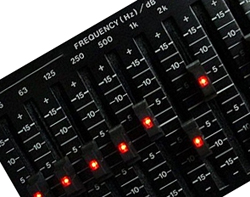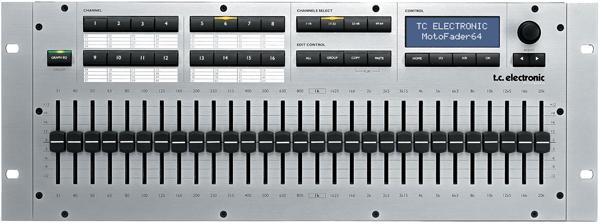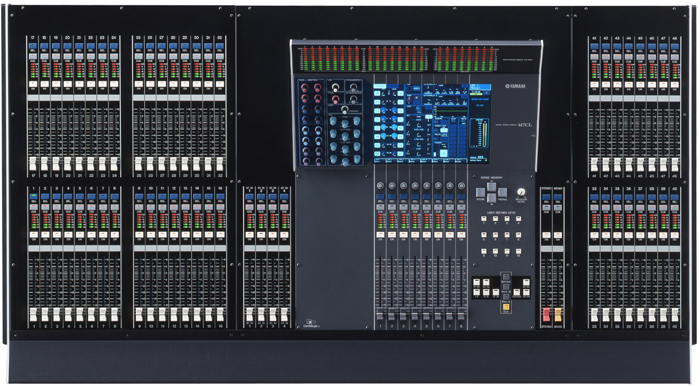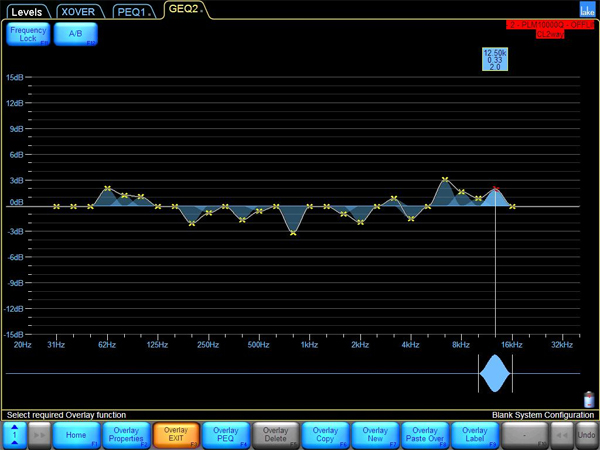
If you’ve ever watched old sound guys who are comfortable using a graphic EQ, it’s quite normal to see them pull a frequency and then put back some gain from the adjacent filters to sharpen the response of the frequency they’re trying to remove.
If you’ve ever felt like you were struggling with the graphs in a monitor rig at low levels of cut, you probably were using a graph with “proportional Q.”
Old school models of graphic equalizers have proportional Q or “variable Q” filters, meaning that they’re sharper at extreme amounts of boost or cut, but at lower gain, the shape of the filter is broad. The result is that small amounts of adjacent boost combine to provide an overall gain that is greater than indicated by the physical controls on the front panel because of the filters’ overlap.
In the 1980s Rane Corporation pioneered the development of “constant Q” or “constant bandwidth” filters for graphic equalizers, which maintain the same narrow Q or bandwidth at low boost or cut as they have at high gain, making them better suited for treating room modes or feedback control. These days many brands of graphic equalizers provide constant Q filters, including models from Ashly, Carvin, dbx and XTA.
In the 1990s BSS introduced the FCS-960 Dual Mode graphic equalizer which provided constant Q filters with the ability to sharpen their response by engaging a single switch.
In the “normal” mode the 960’s filters provide smooth summation from one filter to the next, even at large amounts of boost or cut, better for use as tone controls for sweetening.
In the “fine” mode its filters are sharpened to more precisely cut or boost frequencies within the intended third octave range, earning them favor amongst engineers over other graphic equalizers for notching room modes and for feedback control.
A decade ago the Ashly Protea introduced affordable remotely controlled programmable graphic EQ with their 4-channel 4.24G digital EQ. Its hand-held LCD 4.24RD remote controller can be used over a pair of XLRs up to 1,000 feet long.
Its 48k Hz sampling rate helped monitor engineers grow accustomed to 1.46 ms latency in monitor mixing, and it provides cut and boost of up to 15 dB with a Q of 3.2 (0.45 octave).
Shortly thereafter Sabine introduced the Graphi-Q, a digital equalizer with an analog front-panel interface.
In addition to a compressor/limiter, digital delay and high- and low-pass filters, it also incorporates a dozen parametric filters per channel that can also be used as Sabine’s FBX Feedback Exterminator filters.
It can automatically “ring out” a monitor mix in Turbo mode, placing narrow FBX notch filters at frequencies where feedback occurs. Another notable feature is the ability to define the bandwidth of its graphic filters from 0.5 to 1.0 octave.
Several years ago I got hooked on the TC Electronic EQ Station, a 2U DSP frame with eight channels of graphic EQ, each with an additional 12-band parametric EQ, as well as 3-band dynamic EQ, delay and limiter.
It offers four popular graphic EQ types, including BSS 960, KT DN27 and their own borrowed from the TC 1128. Like its predecessor’s companion 6032 remote motorized fader “head,” the EQ Station also has a moving fader remote, the Motofader 64 with 29 motorized 60 mm faders, which vaguely resemble a DN27.
Nearly all digital consoles have on-board graphic equalizers, and most can use their moving faders to represent the settings of the faders of their graphic EQs and adjust them.
One favorite is Yamaha’s LS9-32, which is able to use all of its faders to represent a 31-band graphic EQ in its entirety; the only digital console that I’m aware is able to do so.
This makes it easy to once again visualize the entire equalizer and quickly make decisions, similar to the power of seeing auxiliary send mixes represented on the same faders.
There’s another simple yet clever graphic EQ feature on the LS9 that’s worth mentioning. The eight internal processors in its “virtual rack” can be programmed as either effects or 31-band monographic EQs.
To economize DSP, they also provide the innovative stereo “Flex15GEQ” which allows up to 15 of the 31 graphic EQ filters to be used on either of two channels, effectively doubling the amount of graphic EQ, with hats off to the old chestnut of using “half the graph.”
The Rane’s DEQ-60 is another stereo digital equalizer with analog front-panel sliders. As a digital processor, the synthesized filters can be created with steeper slopes whose narrow shoulders produce less interaction between bands.
The DEQ-60 offers a choice of classic proportional Q filters, or their proprietary non-combining “Perfect Q” filters, designed to provide response that accurately emulates graphic fader settings.
Clearly, with the advent of digital consoles, there’s interest in keeping the signal in the digital domain.
An additional feature is that Serato’s Rane Series TDM plug-in provides the benefits of Rane’s DEQ-60L while living inside a Avid Venue console.
Lab.gruppen’s purchase of Lake from Dolby and the subsequent LM 26 Lake processor is great news for hundreds of professionals who rely on Lake’s Contour and Mesa Quad, the Clair iO, or Dolby’s subsequent stylish Dolby Lake Processor with its Portal front-panel.
Lake’s “Ideal Graphic EQ” employs their patented “raised cosine” topology, a hyped version of the traditional bell-shaped parametric profile, with narrower skirts for third-octave filters without overlap that provide a flat summation response.
One striking feature they share is use of Lake Controller software from a wireless tablet, giving the system engineer the ability to EQ from the “sweet spot” or the “zone of interest.”
Additionally, integration of Rational AcousticsSmaart within the Lake Controller interface provides nearly all of Smaart’s features from the same wireless tablet.
Besides the rich graphics of Smaart, the benefit of graphic EQ outside the mixing console is its ability to evolve independently of various consoles and to integrate with wireless control and monitoring.
Mark Frink is a veteran touring engineer and long-time writer/editor in professional audio.







